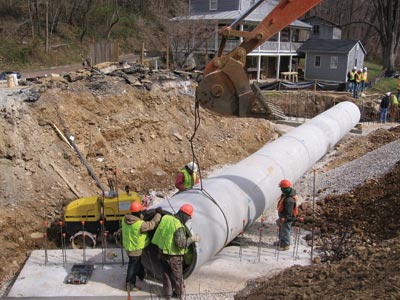Transportation Asset Management Case Studies
CMS Case Study
Conclusion
Discussions with various DOTs around the country confirm a need to better manage all types of highway assets. Since culverts typically go unnoticed, there has not always been a sense of urgency to inspect or manage these structures. But as recent high-profile failures on Interstate and State highways around the Nation have occurred, the need to manage these structures has become apparent.
There are several keys to a high-quality, comprehensive management system applicable to culverts and drainage structures. Based on AASHTO guidelines, the purpose of a CMS is to use economic and engineering data to help determine the best actions to perform on the network of culverts over a period of time. An effective CMS includes these key components:
- Inventory.
- Inspection and condition appraisal.
- Cost data:
- Agency costs (i.e., maintenance, repair, and replacement).
- User costs.
- Deterioration models.
- Optimization models.
- Feasible actions and work needs.
- Scheduling.
- Reporting.
Although many DOTs have some form of CMS in place or under development, not all systems have all of the key components. FHWA has taken an initial step toward helping DOTs manage their culvert inventory. In October 2001, FHWA released CMS software along with a user's manual. The purpose of this program is to provide a tool to facilitate the coordination of maintenance and repair or replacement operations on a system-wide basis.
Many States have expressed interest in the FHWA CMS. The University Transportation Center of Alabama (UTCA) along with the SCHD has sponsored implementation seminars for the FHWA CMS software. The target audience of these seminars is county and city engineers, maintenance personnel, and contractors. In addition to discussing culvert inspection techniques and design philosophies, the seminar participants receive a copy of the FHWA CMS software and manual. Part of the seminar demonstrates how to build a culvert database using this software. Following the seminars, a written report documents the outcomes, participants' comments and questions, and recommendations. One recommendation was to update and enhance the existing software and to fix any errors that are discovered. Currently, FHWA is not actively supporting the maintenance of this program. The UTCA supports the concept that FHWA, through its Office of Asset Management, take ownership of the distribution, maintenance, and future enhancements of the CMS.
According to a survey of State DOT culvert management programs, many States are not using any type of formal management system for structures under 20 ft in length. DOTs who do use a system vary widely in the ways that they inspect, inventory, budget, and make decisions, not only from State to State but also within different divisions of the same agency.
Although many States recognize the importance of culverts and drainage structures, the lack of an actively promoted CMS and a current culvert inspection course could be a reason that more resources are not dedicated to culvert management. These facts have been taken into consideration by FHWA. As a result, FHWA will begin development of new culvert inspection training material and an updated and enhanced FHWA CMS.

An effective CMS helps highway agencies to enhance highway safety, use resources more efficiently, and preserve public assets:
- With the increased systematic attention to culvert inspection that accompanies use of a CMS, structures in need of repair or replacement can be identified before their condition is a risk for catastrophic failure.
- The prioritization of rehabilitation, repair, and replacement needs offered by a CMS helps agencies to optimize their use of the limited human and financial resources they have available.
- Finally, a CMS can help agency decision makers preserve the Nation's investment in highway infrastructure as they decide how best to spend resources to maintain culverts throughout the highway network.

